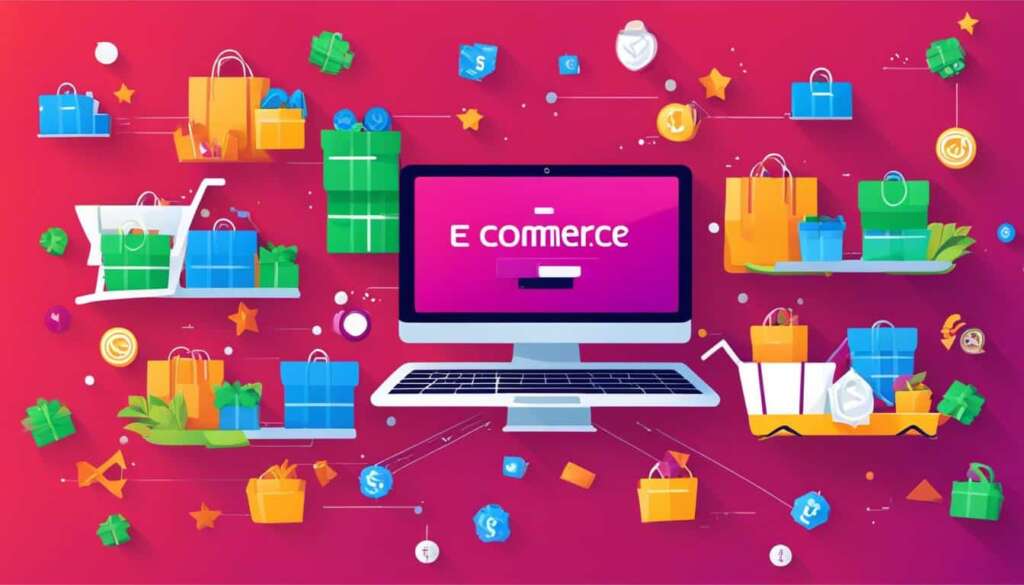Table of Contents
E-commerce business has become a cornerstone of online commercial success. With the operational facets of setting up and running an online business, entrepreneurs can tap into a vast market and achieve global reach. By understanding the fundamentals of e-commerce, businesses can leverage the power of technology to establish successful ventures in the digital landscape.
In this article, we will delve into the essential aspects of e-commerce, exploring what it is and how it works. We will also discuss the different types of e-commerce businesses and revenue models, as well as the benefits and challenges they present. Whether you’re a budding entrepreneur or an established business looking to expand your online presence, this guide will provide valuable insights to help you navigate the world of e-commerce.
What is Ecommerce?
Ecommerce, also known as electronic commerce, refers to the buying and selling of goods and services online. It has become a significant part of the global economy, revolutionizing the way people conduct business and shop. With the rise of the internet and advancements in technology, ecommerce has gained immense popularity and continues to grow rapidly.
Online shopping is a key aspect of ecommerce, allowing consumers to browse and purchase products from the comfort of their own homes or any location with an internet connection. This convenience has made online shopping increasingly popular, attracting a wide range of customers.
Electronic payments are the foundation of ecommerce, serving as the transactional method for purchasing goods or services online. These payments are typically made through secure online platforms, ensuring the protection of sensitive financial information.
Ecommerce encompasses various channels through which transactions can take place. Online stores, such as retail websites, provide a dedicated platform for businesses to showcase and sell their products. Social media platforms also play a vital role in ecommerce, as businesses utilize these platforms to reach and engage with customers. Additionally, online marketplaces, such as Amazon and eBay, offer a diverse range of products from multiple sellers.
“The future of retail is online. Ecommerce has transformed the way consumers shop and businesses operate, providing unparalleled convenience and endless possibilities.”
Ecommerce extends beyond online shopping; it encompasses a wide range of activities. Online auctions provide a platform for individuals and businesses to bid on and sell products. Internet banking enables customers to manage their finances and conduct transactions electronically.
Advantages of Ecommerce
Ecommerce offers numerous advantages for consumers and businesses:
- Convenience: Online shopping allows customers to shop at any time and from anywhere, eliminating the need to visit physical stores.
- Wide Product Selection: Ecommerce provides access to a vast array of products from different brands and sellers, allowing customers to find exactly what they’re looking for.
- Competitive Prices: The online marketplace fosters competition, leading to competitive pricing and better deals for consumers.
- Global Reach: Ecommerce breaks down geographical barriers, enabling businesses to reach customers worldwide and expand their target audience.
- Time and Cost Efficiency: Online shopping saves time and money by eliminating the need for travel and reducing operational costs for businesses.
Challenges of Ecommerce
While ecommerce offers significant benefits, it also presents challenges:
- Customer Trust: Establishing trust is crucial for ecommerce businesses, as customers need assurance that their personal and financial information is secure.
- Product Experience: Customers cannot physically touch or try products before purchasing, which can lead to uncertainty and potential returns.
- Shipping Wait Time: Customers expect fast and reliable shipping, and any delays can result in customer dissatisfaction.
- Competition: The online marketplace is highly competitive, making it essential for businesses to differentiate themselves and attract customers amidst a sea of options.
| Ecommerce Advantages | Ecommerce Challenges |
|---|---|
| Convenience | Customer Trust |
| Wide Product Selection | Product Experience |
| Competitive Prices | Shipping Wait Time |
| Global Reach | Competition |
| Time and Cost Efficiency |
How Does Ecommerce Work?
When a customer engages in an ecommerce transaction, the online retailer takes charge of delivering the order, be it physical products or digital services. The process involves seamless communication between the customer’s web browser, the online store’s server, and multiple databases and systems responsible for managing inventory and payment information. Ecommerce transactions can take place on various devices and platforms, with a diverse range of payment methods available to customers. The procedure encompasses order validation, notifying the customer, and dispatching products or granting access to services for a fulfilling ecommerce experience.
Understanding the inner workings of ecommerce transactions is vital for both customers and online retailers. Let’s explore the detailed process:
- Order Placement: The customer adds desired products to their online shopping cart and initiates the checkout process. They provide necessary information, such as shipping address and payment details, to finalize the purchase.
- Transaction Authorization: The customer’s web browser securely transmits the payment information to the online retailer’s server, which then verifies the authenticity and validity of the transaction.
- Payment Processing: If the transaction is authorized, the online retailer securely transfers the payment to the appropriate payment gateway or processor for further processing. This may involve encryption algorithms and other security measures to ensure the safe transfer of sensitive financial information.
- Inventory Management: Simultaneously, the online retailer’s systems communicate with various databases and inventory management software to ensure the availability of the purchased products or services. This step ensures that the ordered items are in stock or can be sourced in a timely manner.
- Order Confirmation: Once the payment is successfully processed and the inventory is confirmed, the online retailer generates an order confirmation notification and sends it to the customer, reassuring them that their purchase has been received and is being processed.
- Order Fulfillment: At this stage, the online retailer prepares the order for shipment or access. Physical products are carefully packaged and dispatched for delivery, while digital services may involve granting access to online platforms or downloading relevant files.
- Shipping and Delivery: For physical products, the online retailer arranges for shipping and provides the customer with tracking information. The customer can then monitor the progress of the delivery until it reaches its destination.
- Customer Support: Throughout the transaction process, online retailers should offer reliable customer support to address any inquiries or concerns raised by customers. Providing timely assistance contributes to a positive customer experience.
Understanding the intricacies of how ecommerce transactions work enables online retailers to establish efficient order fulfillment systems. It also empowers customers to confidently engage in online shopping, knowing that their purchases will be securely processed and delivered in a timely manner. Successful ecommerce businesses invest in robust systems and technologies that streamline the entire transaction process, ensuring seamless experiences for customers.

Types of Ecommerce Businesses Explained
When it comes to ecommerce, there are various types of businesses depending on the parties involved in the transactions. Let’s explore these different types:
1. Business-to-Consumer (B2C) Ecommerce
In B2C ecommerce, businesses sell their goods or services directly to individual consumers. This is the most common type of ecommerce that people are familiar with. Examples include online retailers like Amazon and clothing brands like Zara, which sell their products directly to customers.
2. Business-to-Business (B2B) Ecommerce
B2B ecommerce refers to transactions between businesses. In this type of ecommerce, companies sell their products or services to other businesses. Wholesale suppliers, manufacturers, and software providers are common examples of B2B ecommerce. Platforms like Alibaba and Shopify Plus cater specifically to B2B commerce.
3. Consumer-to-Consumer (C2C) Ecommerce
C2C ecommerce involves individuals trading products or services directly with one another. Online marketplaces like eBay and Etsy enable individuals to sell their used items or handmade crafts to other consumers. This type of ecommerce allows individuals to monetize their skills or sell second-hand items.
4. Consumer-to-Business (C2B) Ecommerce
C2B ecommerce occurs when individuals sell their products or services to businesses. This can include freelance professionals offering their services to companies or influencers partnering with brands for sponsored content. Websites like Fiverr and Upwork facilitate C2B transactions.
5. Direct-to-Consumer (D2C) Brands
D2C brands have gained popularity in recent years, as they sell products directly to consumers without intermediaries or distributors. By bypassing traditional retail channels, D2C brands can maintain control over their brand experience and build stronger relationships with their customers. Examples of successful D2C brands include Warby Parker in eyewear and Casper in mattresses.
Understanding the different types of ecommerce businesses is crucial for entrepreneurs looking to enter the online retail space. Each type has its own dynamics and considerations, so it’s essential to choose the most suitable model based on the products or services being offered.
With the right ecommerce model, businesses can tap into the vast potential of the digital marketplace and drive commercial success.
5 Ecommerce Revenue Models
Ecommerce businesses have the opportunity to generate revenue through various models. Understanding these revenue models is crucial for building a successful online business. Let’s explore five common ecommerce revenue models:
Sales Model
The Sales Model is the most traditional revenue model in ecommerce. It involves selling products and services for a profit. With the sales model, businesses earn revenue by offering a range of products or services to customers who make purchases through their online platforms. Whether it’s selling clothing, electronics, or digital products, the sales model focuses on driving sales and achieving profitability.
Subscription Model
The Subscription Model is a popular revenue model for businesses offering recurring products or services. It relies on customers subscribing to receive regular deliveries or access to specific content. Companies offering subscription boxes, software-as-a-service (SaaS) solutions, or streaming platforms benefit from the recurring revenue generated by loyal subscribers. The subscription model provides a predictable income stream and fosters long-term customer relationships.
Advertising Model
The Advertising Model involves earning revenue from advertising deals or promoted content. Ecommerce businesses can monetize their platforms by displaying relevant advertisements to their audience. By partnering with advertisers, these businesses can generate income through pay-per-click (PPC) ads, display ads, sponsored content, or affiliate marketing. The advertising model allows businesses to leverage their website traffic and customer base to earn additional revenue.
Affiliate Model
The Affiliate Model offers businesses and individuals the opportunity to earn commission by promoting products through affiliate links. Ecommerce businesses can partner with affiliates who promote their products or services through blogs, social media, or other platforms. When customers make purchases through the affiliate’s unique link, the affiliate receives a commission. The affiliate model is a cost-effective way for businesses to expand their reach and drive sales through the influence of trusted affiliates.
Transaction Fee Model
The Transaction Fee Model applies to ecommerce companies that process financial transactions and earn revenue by charging a fee on each sale. These companies provide platforms or marketplaces where buyers and sellers can connect. For each transaction facilitated on the platform, a transaction fee is charged. This revenue model allows ecommerce businesses to profit by facilitating transactions between buyers and sellers without directly selling products or services themselves.
These five ecommerce revenue models provide entrepreneurs with different approaches to monetize their online businesses. Depending on the nature of the products or services offered, businesses can choose a revenue model that aligns with their goals and target market.
The Benefits of Ecommerce Businesses
Ecommerce businesses offer a range of advantages that contribute to their popularity and success. These benefits include:
Convenience
Ecommerce provides convenience for customers to shop from anywhere and at any time. With just a few clicks, shoppers can browse through a wide range of products and make purchases without leaving the comfort of their homes. This convenience is especially beneficial for busy individuals who may not have the time to visit physical stores.
Global Reach
One of the key advantages of ecommerce is its global reach. Online businesses can easily target and reach customers in different countries, expanding their customer base significantly. With the internet connecting people worldwide, ecommerce allows businesses to tap into new markets and establish a presence internationally.
Product Selection
Ecommerce offers an extensive selection of products and services. Online stores can showcase a wide range of items, allowing customers to find exactly what they are looking for. Whether it’s clothing, electronics, or niche products, ecommerce provides customers with a vast array of options, ensuring that they can find the products that suit their needs and preferences.
Price Transparency
Price transparency is another notable benefit of ecommerce. Online stores often provide clear pricing information, allowing customers to compare products and prices easily. With this transparency, customers can make informed purchasing decisions, ensuring that they get the best value for their money. Ecommerce businesses that offer competitive prices can attract customers and maintain a strong position in the market.
These advantages make ecommerce a compelling choice for businesses and consumers alike. By leveraging convenience, global reach, product selection, and price transparency, ecommerce businesses can broaden their customer base, drive sales, and achieve sustainable growth.
The Challenges of Ecommerce Businesses
Ecommerce businesses face several challenges that can impact the customer experience and overall success of the business. It is essential to address these challenges effectively to ensure customer satisfaction and maintain a competitive edge in the online market.
Limited Customer Service:
Compared to physical stores, ecommerce businesses may have limited customer service capabilities. While online support and chat systems can assist customers, it may not always match the personalized assistance available in brick-and-mortar stores. Providing comprehensive and responsive customer service is crucial to address inquiries, resolve issues, and build customer loyalty.
Product Experience:
One of the challenges of ecommerce is that customers cannot physically see or touch products before purchasing. This lack of sensory experience can lead to uncertainty and dissatisfaction. To enhance the product experience, ecommerce businesses should provide high-quality product images, detailed descriptions, and customer reviews to help customers make informed decisions.
Shipping Wait Time:
Delivery time is a critical factor for customer satisfaction in online shopping. Customers have come to expect quick and efficient shipping, and any delays can lead to frustration. Ecommerce businesses need to optimize their logistics processes, collaborate with reliable shipping partners, and provide accurate delivery estimates to manage customer expectations.
Security:
Security is a significant concern for ecommerce businesses and their customers. Hackers can create fraudulent websites, compromise customer data, and engage in cybercrime. Implementing robust security measures, such as using secure payment gateways, encrypting customer data, and regularly updating security systems, is essential to safeguard customer information and build trust.
By addressing the challenges of limited customer service, product experience, shipping wait time, and security, ecommerce businesses can create a positive customer experience, foster customer loyalty, and strengthen their market position.

Conclusion
The ecommerce industry has brought about a significant transformation in the retail sector, providing businesses with unprecedented opportunities for growth. With the ability to reach a global audience, ecommerce businesses can expand their customer base and drive business growth in ways that traditional brick-and-mortar stores cannot. By understanding the fundamentals of ecommerce and strategically leveraging online retail, entrepreneurs can establish successful businesses in this dynamic industry.
Despite the challenges that ecommerce businesses may face, the benefits far outweigh the obstacles. The convenience offered by ecommerce allows customers to shop from the comfort of their own homes, at any time that suits them. Additionally, ecommerce provides businesses with access to a wide customer base, giving them the potential to reach customers from all over the world. This global audience opens up new possibilities for business growth and expansion.
To achieve online commercial success, careful planning and execution are essential. Entrepreneurs must take into account the unique characteristics of the ecommerce industry, including customer service considerations, ensuring a positive product experience, and addressing shipping concerns. Moreover, prioritizing the security of customer data is crucial to building trust and maintaining the integrity of the ecommerce business.
As the ecommerce industry continues to evolve and shape the future of retail, entrepreneurs have the opportunity to tap into its vast potential. By embracing the benefits of ecommerce, such as convenience and a global audience, businesses of all sizes can thrive in this ever-growing market. With the right strategies in place, ecommerce businesses can achieve sustainable growth and establish themselves as key players in the global marketplace.
FAQ
What is an ecommerce business?
An ecommerce business refers to the buying and selling of goods and services online, often through online stores, social media platforms, or online marketplaces.
How does ecommerce work?
Ecommerce transactions involve communication between the customer’s web browser, the online store’s server, and various databases and systems that manage inventory and payment information. After a purchase is made, the online retailer delivers the order physically or digitally.
What are the different types of ecommerce businesses?
There are several types of ecommerce businesses, including business-to-consumer (B2C) where goods or services are directly sold to individual consumers, business-to-business (B2B) where transactions occur between businesses, consumer-to-consumer (C2C) where individuals trade products or services, consumer-to-business (C2B) where individuals sell their products or services to businesses, and direct-to-consumer (D2C) where brands sell directly to consumers without intermediaries.
What are the revenue models used by ecommerce businesses?
Ecommerce businesses can generate revenue through various models, including the sales model where products and services are sold for profit, the subscription model where recurring revenue is generated from subscriptions, the advertising model where revenue is earned from advertising deals or promoted content, the affiliate model where businesses or individuals earn commission by promoting products through affiliate links, and the transaction fee model which applies to ecommerce companies that process financial transactions and charge a fee on each sale.
What are the benefits of ecommerce businesses?
Ecommerce businesses offer several benefits, including the convenience for customers to shop from anywhere and at any time, access to a global audience, a wide selection of products and services, and price transparency that allows customers to easily compare products and prices.
What challenges do ecommerce businesses face?
Ecommerce businesses face challenges such as limited customer service compared to physical stores, customers not being able to see or touch products before purchase, shipping wait times, and security issues such as fraudulent websites or compromised customer data.
How has the ecommerce industry revolutionized the retail sector?
The ecommerce industry has revolutionized the retail sector by providing businesses with the opportunity to reach a global audience and drive business growth. With careful planning and execution, entrepreneurs can tap into the vast potential of ecommerce and achieve online commercial success.













